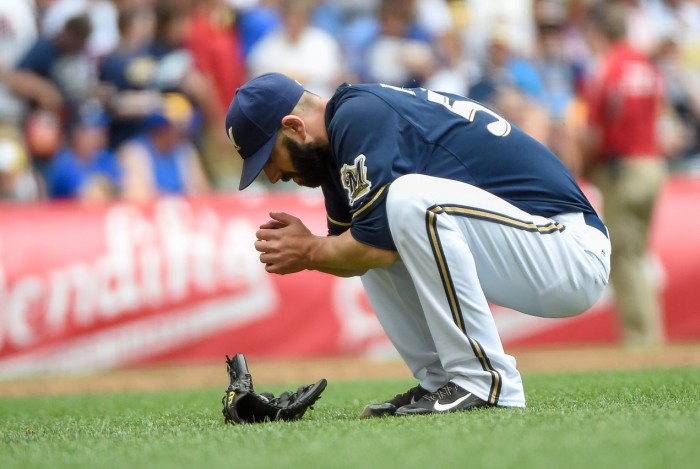Much has been said about the state of the Brewers’ rotation, as the general struggles for Milwaukee have been lamented ad nauseam. Fans do little to celebrate as the rotation ranks near the bottom in the most pertinent pitching stats.
| 2015 ERA/FIP/WAR | Rank | |
|---|---|---|
| ERA | 4.80 | 28th |
| FIP | 4.43 | 26th |
| WAR | +3.3 | 27th |
Despite the deplorable performance of the rotation as a whole, one promising note bears mentioning: right-hander Mike Fiers. It is an unfortunate situation when specific praise is doted upon a pitcher that is the not-so-proud owner of a 3.96 ERA, 3.92 FIP, 4.00 DRA (Deserved Run Average), and +1.6 WAR. However, when Fiers is removed from the rotation, the rotations numbers become even more atrocious.
| 2015 ERA/FIP/WAR (Without Fiers) | Rank | |
|---|---|---|
| ERA | 5.53 | 30th |
| FIP | 4.81 | 29th |
| WAR | +0.7 | 30th |
There really isn’t much difference between being ranked 27th in WAR and 30th in WAR. However, ranking aside, the fact that Fiers is worth 2.6 wins of the Brewers 3.3 WAR highlights how miserable the pitchers around him have truly been. Make no mistake, Fiers is not an ace. However, there is undeniable value that he’s providing and projects to continually provide while the franchise rebuilds.
Fiers pitched his first full season with the Brewers in 2012, back when Randy Wolf and Zack Greinke were still in the rotation. While Fiers finished the season with a 3.74 ERA and 3.14 FIP, he was still worth +3.4 WARP. Fiers’ 2013 season was cut short after suffering a freak injury in the minors, breaking his arm, but he struggled mightily before that. As a result, his 2014 campaign was also limited because he began in Triple-A Nashville. In total, between those two seasons, Fiers pitched 94 major-league innings. When looking at his combined stats from 2013-2014, though, Fiers posted a 3.35 ERA, a 3.95 FIP and was worth +0.8 WARP. When looking at “rest-of-season” projections for 2015, Fiers looks to finish quite well, at least relative to the rest of the rotation. PECOTA predicts that Fiers will finish with a 3.57 ERA and be worth an additional 0.7 wins above replacement.
As for Garza and Lohse, their ERAs and FIPs are projected to drop, but sadly, both should remain north of 4.00. Digging a little deeper to see what PECOTA has to say, the outlook on Fiers is even more positive. Looking at again ERA and FRA (Fair Run Average), Fiers is supposed to post solid numbers — to the tune of a 3.25 ERA and 3.54 FRA in 2016. Meanwhile, the PECOTA forecast for Garza is a 4.10 ERA and 4.45 FRA for the 2016 season. I’m not including Lohse in the 2016 discussion because his tenure in Milwaukee is likely done.
The return on investment from both Garza and Lohse has been disappointing, at best, even if Lohse’s issues have only been in 2015. Over the last season, they have posted a combined 4.42 ERA and 4.16 FIP. In that same time frame, their cumulative WARP is +1.4 in 563.2 innings pitched. With Milwaukee, Fiers has pitched 317.2 innings and has accrued 5.1 wins above replacement, again, according to Baseball Prospectus.
And while Garza and Lohse have cost the Brewers $23.5 million in 2014 and an additional $23.5 million by the end of 2015, Fiers only costs the club $512,500 — slightly above the league minimum. In fact, Fiers will continue to earn near the league minimum since he is not arbitration eligible until 2017, his age-32 season. The simple reality of most pitching rotations is that five guys need to pitch every five games. Rotation spots cannot be skipped. While Milwaukee rebuilds, having a serviceable pitcher at or near the league minimum means that the team can use its resources on other things, like pitchers not named Matt Garza. Having Fiers under team control for the next five years puts the Brewers in a favorable position during and after his arbitration years.
It is not unheard of for ballclubs to sign pitchers that are older than 30 to modest multi-year contracts. In fact, former Brewer, Chris Capuano signed with the Dodgers in 2012 for a two-year, $9 million contract heading into his age-33 season. Brandon McCarthy is another pitcher over 30 that is signed to a four-year, $48 million contract that ends when he is 34 years old. Neither Capuano nor McCarthy finished a season with a sub-3.00 ERA prior to their multi-year deals. Given Fiers’ age when he becomes arbitration eligible and the potential market for back-of-rotation pitchers in 2017, it is in the best interest of the Brewers to negotiate through his arbitration years. What they will be getting in Fiers is a far superior pitcher than Capuano and one that is more durable than McCarthy has proven to be, but what could come at fraction of the cost.
